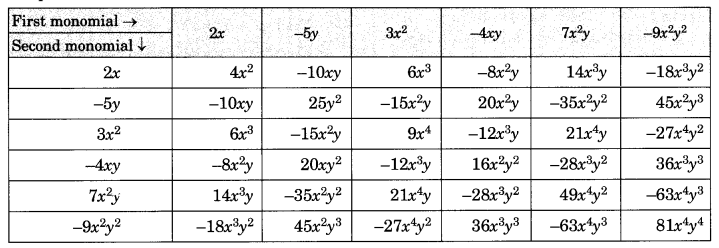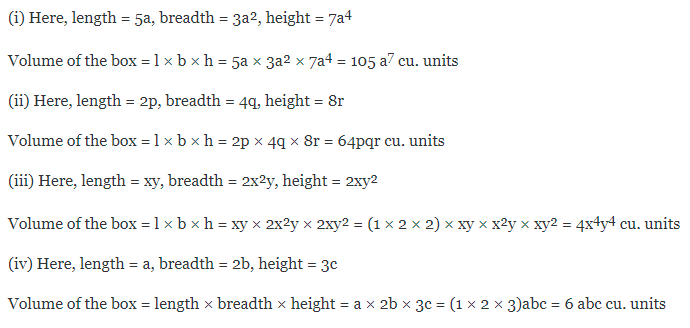Solutions For All Chapters Maths Class 8
Ex 8.2 Class 8 Maths Question 1.
Find the product of the following pairs of monomials.
(i) 4, 7p
(ii) -4p, 7p
(iii) -4p, 7pq
(iv) 4p³, -3p
(v) 4p, 0
Solution:
(i) 4 × 7p = (4 × 7) × p = 28p
(ii) -4p × 7p = (-4 × 7) × p × p = -28p²
(iii) -4p × 7pq = (-4 × 7) × p × pq = -28p²q
(iv) 4p³ × -3p = (4 × -3) × p³ × p = -12p4
(v) 4p x 0 = (4 × 0) × p = 0 × p = 0
Ex 8.2 Class 8 Maths Question 2.
Find the areas of rectangles with the following pairs of monomials as their lengths and breadths respectively.
(p, q); (10m, 5n); (20x², 5y²); (4x, 3x²); (3mn, 4np)
Solution:
(i) Length = p units and breadth = q units
Area of the rectangle = length × breadth = p × q = pq sq units
(ii) Length = 10 m units, breadth = 5n units
Area of the rectangle = length × breadth = 10 m × 5 n = (10 × 5) × m × n = 50 mn sq units
(iii) Length = 20x² units, breadth = 5y² units
Area of the rectangle = length × breadth = 20x² × 5y² = (20 × 5) × x² × y² = 100x²y² sq units
(iv) Length = 4x units, breadth = 3x² units
Area of the rectangle = length × breadth = 4x × 3x² = (4 × 3) × x × x² = 12x³ sq units
(v) Length = 3mn units, breadth = 4np units
Area of the rectangle = length × breadth = 3mn × 4np = (3 × 4) × mn × np = 12mn²p sq units
Ex 8.2 Class 8 Maths Question 3.
Complete the table of Products.
Solution:
Completed Table
Ex 8.2 Class 8 Maths Question 4.
Obtain the volume of rectangular boxes with the following length, breadth and height respectively.
(i) 5a, 3a², 7a4
(ii) 2p, 4q, 8r
(iii) xy, 2x²y, 2xy²
(iv) a, 2b, 3c
Solution:
Ex 8.2 Class 8 Maths Question 5.
Obtain the product of
(i) xy, yz, zx
(ii) a, -a², a³
(iii) 2, 4y, 8y², 16y³
(iv) a, 2b, 3c, 6abc
(v) m, -mn, mnp
Solution:
(i) xy × yz × zx = x²y²z²
(ii) a × (-a²) × a³ = -a6
(iii) 2 × 4y × 8y² × 16y³ = (2 × 4 × 8 × 16) × y × y² × y3 = 1024y6
(iv) a × 2b × 3c × 6abc = (1 × 2 × 3 × 6) × a × b × c × abc = 36 a²b²c²
(v) m × (-mn) × mnp = [1 × (-1) × 1 ]m × mn × mnp = -m³n²p




Very understandable answers.I like this app it is very helpful 👍👍
Good
It’s fabulous for students during their studies…
It’s great , with full access too !
Nice
I like this website this website is amazing ✨❤️
Very understandable answers and easy answers . I like this app.This is the best homework app for all thankyou
eVidhyarthi♥️
Very good website i really like it. It will help so much. It also makes easy to understand. It helps students very much